Now that I’m no longer living in Scotland, I must make do with whatever weather I get upon my visits. Summer is no guarantee for sun, and the first weeks of July saw nothing but grey skies and rain. When a spell of good weather is predicted during the week that I return, I can’t pack my rucksack fast enough, and hop on the bus, out of Glasgow and into the Highlands.
This time I bring along my caving buddy Joevie, who is as crazy about the Scottish giants as me. While I was across the sea, I watched as she conquered some of Scotland’s most revered ridges, including Aonach Eagach and the Càrn Mòr Dearg Arête to Ben Nevis. My lust for height grew bigger with every photo report. Now we’re finally heading into the hills together. The route we have in mind is more challenging than either of has ever attempted: 1 corbett and 5 munros in 1 day, more than 30 kms of climbing up and down the remotest region of the Scottish Highlands: the Fisherfield Six. They will test our willpower and punish our feet, but what a reward it will be.
The Fisherfield Forest is a mountainous area in the Northwest Highlands, across from Loch Broom as seen from Ullapool. Contrary to what its name suggests, it is a vast, barren wilderness, with hills bent into mythical shapes. Miles away from human habitation, the area is sometimes nicknamed ‘the Great Wilderness’. It’s almost impossible to reach the furthest munro, A’ Mhaighdean, in one day; most hikers split up the journey with a stay in the open bothy at Shenavall or a camp on a hilltop.
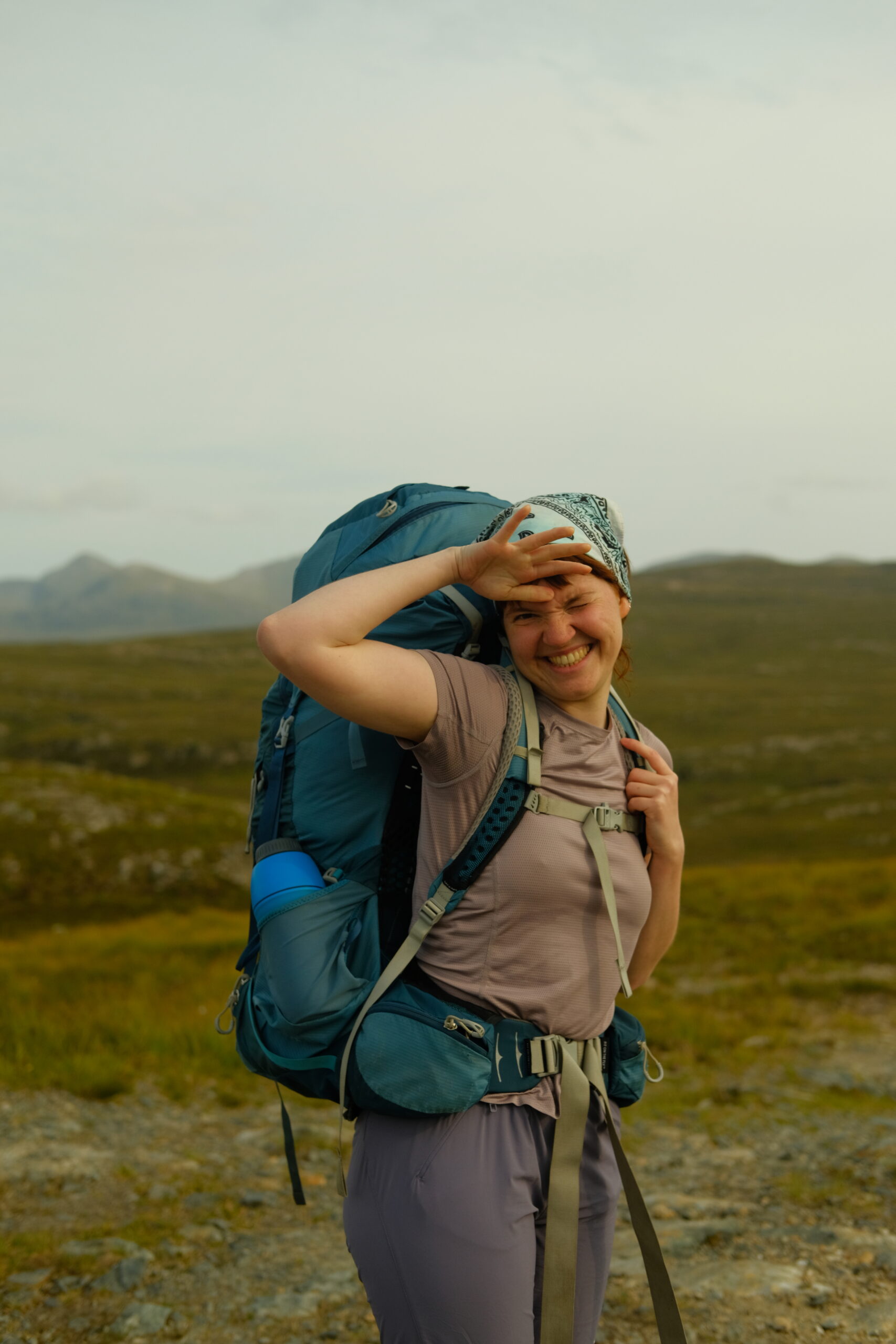
A cosy bothy, good company and six grand hills: it’s music to my ears. A 5 hour bus ride and a short lift to Corrie Harrie later, and we are at the start of our big adventure.
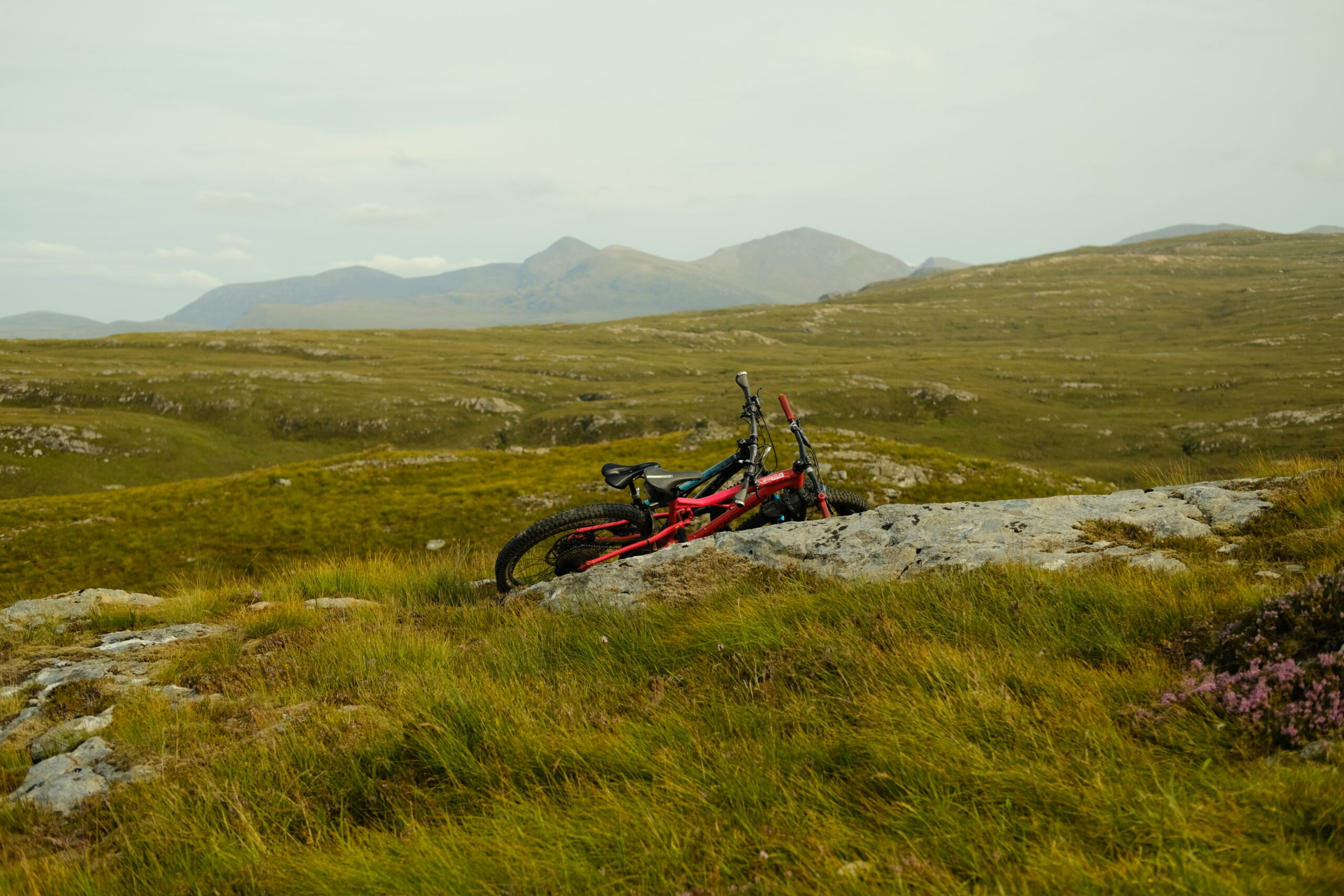
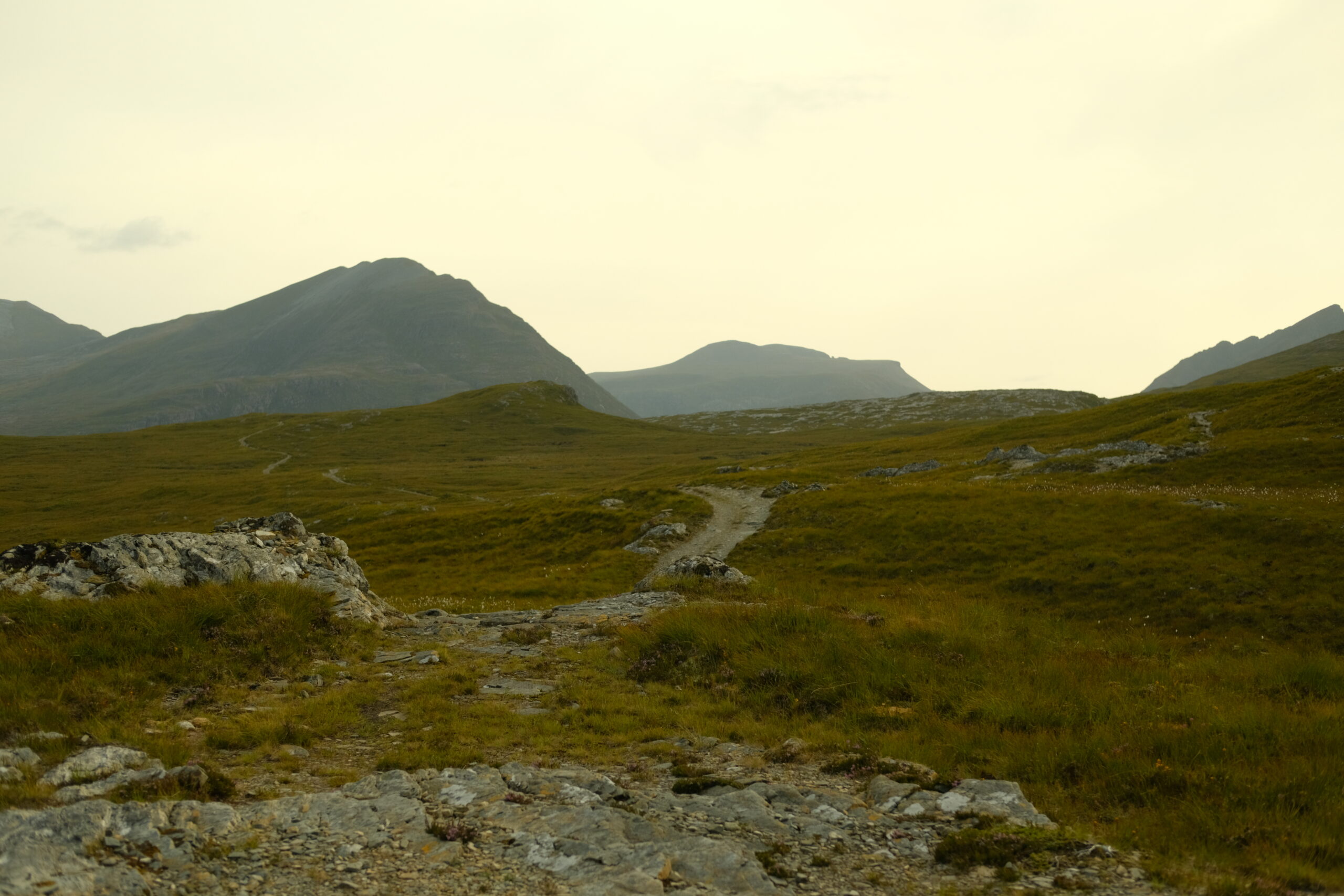
The path to Shenavall climbs gently through a birch forest, before the glen opens up and An Teallach above us reveals its jagged teeth. Distracted by the big orange sun over the green moors we miss the turn for Shenavall, and are forced to take the longer approach towards the glen of the swaying Abhain Loch an Nid, then following the course of the river to Loch na Sealga. On this route we get to see the wide, open plain of Strath na Sealga, the glen that holds Shenavall, in all its glory as the golden hour breaks - a happy accident.
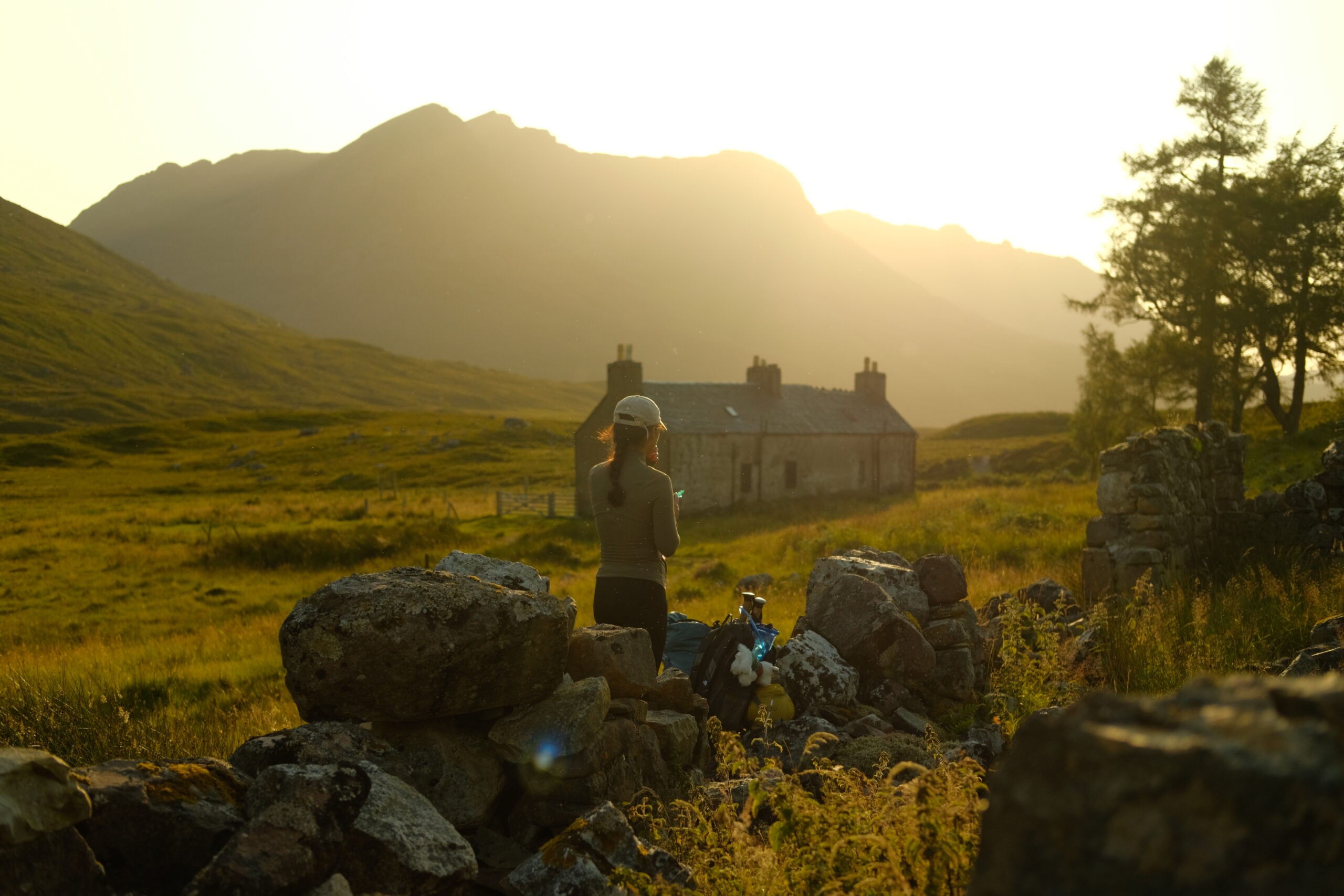
My rucksack is heavy, and during the last miles along the riverbank my feet start to ache. A first warning that we set the bar too high for tomorrow?
Near the bothy more and more tents pop up. This might be the Great Wilderness, it’s a sunny summer day in Scotland, and we are far from the only ones who know this. 'Munro baggers' take their chance to cross the remotest munros off their list. It’s close to sunset when we arrive, and one question remains: is there space for us in the bothy?
Most tents prove to belong to a film crew that is making a fiction film about a hiker on the Cape Wrath Trail (the film is called The North - do keep an eye on their socials, it promises to be a beautiful movie I think). Tonight they are using the ground floor of the bothy as their movie set. I get why: the red light of the setting sun falls perfectly into the window frame where the main character is sitting. I am beyond surprise when I hear the crew speak Dutch; this isn’t the first time I encounter my own people unwittingly, in the most faraway of places.
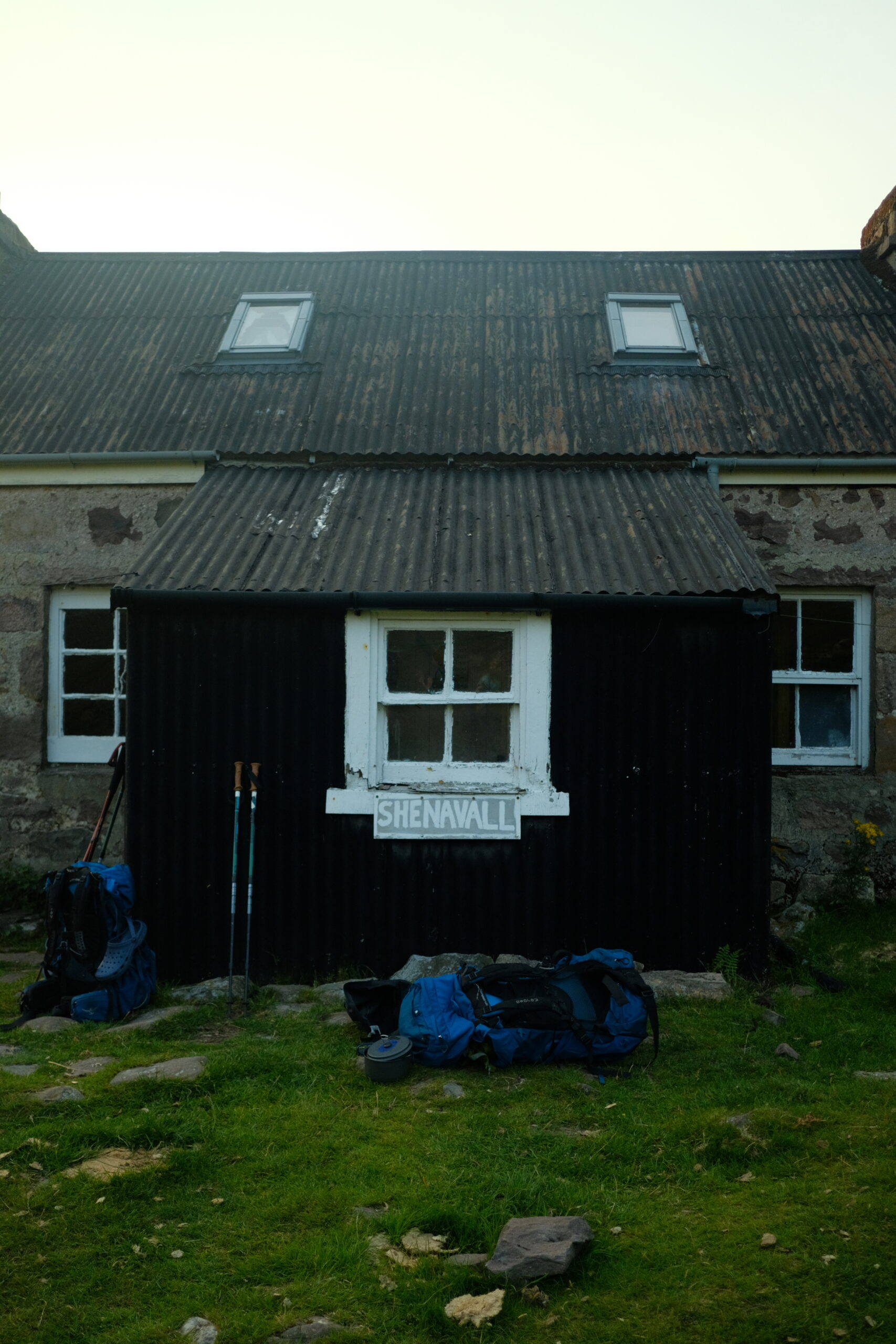
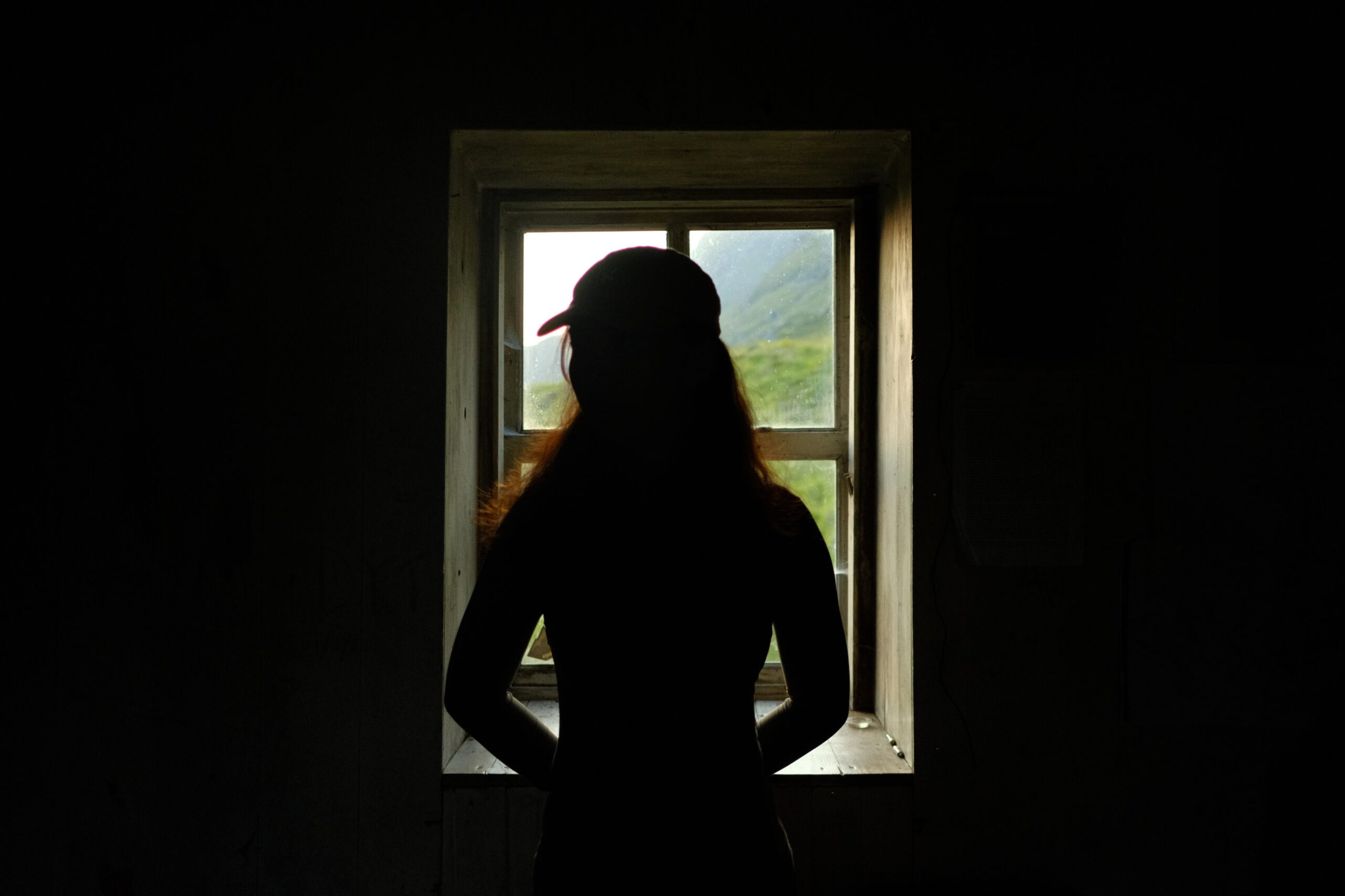
Luckily for us, the crew isn’t going to sleep in the bothy. As of now, there’s only two other sleeping bags lying in the attic. We give the cameramen space to film and go up the hill for sunset. The view is truly magnificent – Beinn Dearg Mòr a bat that spreads its wings over the black roof of Shenavall, the orange reflection of the sun in the lake – but we hardly get to enjoy it; within seconds we are brutally attacked by swarms of midges. Not even my head net can keep them out. We jump back and forth in a frantic attempt to escape them, but tonight the wee bastards are particularly unforgiving. It’s the silent wind and the setting sun that summons them – the yin and yang of Scottish summer; one cannot exist without the other.
Later that night, one after the other hiker pays a visit to the bothy, who has finished the Fisherfield Six today. Racing over the hills, or struggling for 14 hours, all of them have succeeded. Joevie and I keep assuring each other that we’ll just see how far we get, but secretly, something is simmering inside us – surely we can do that too?
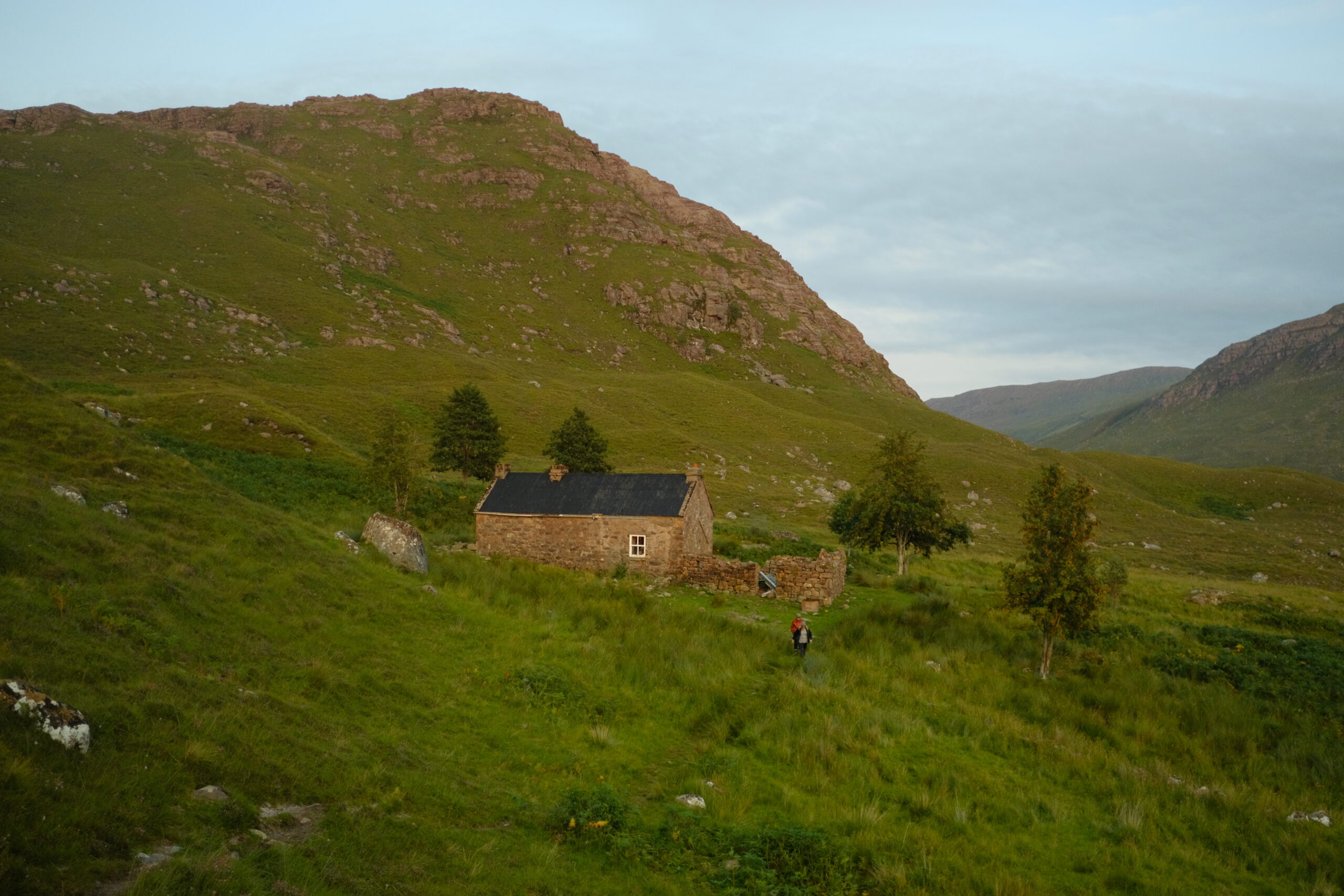
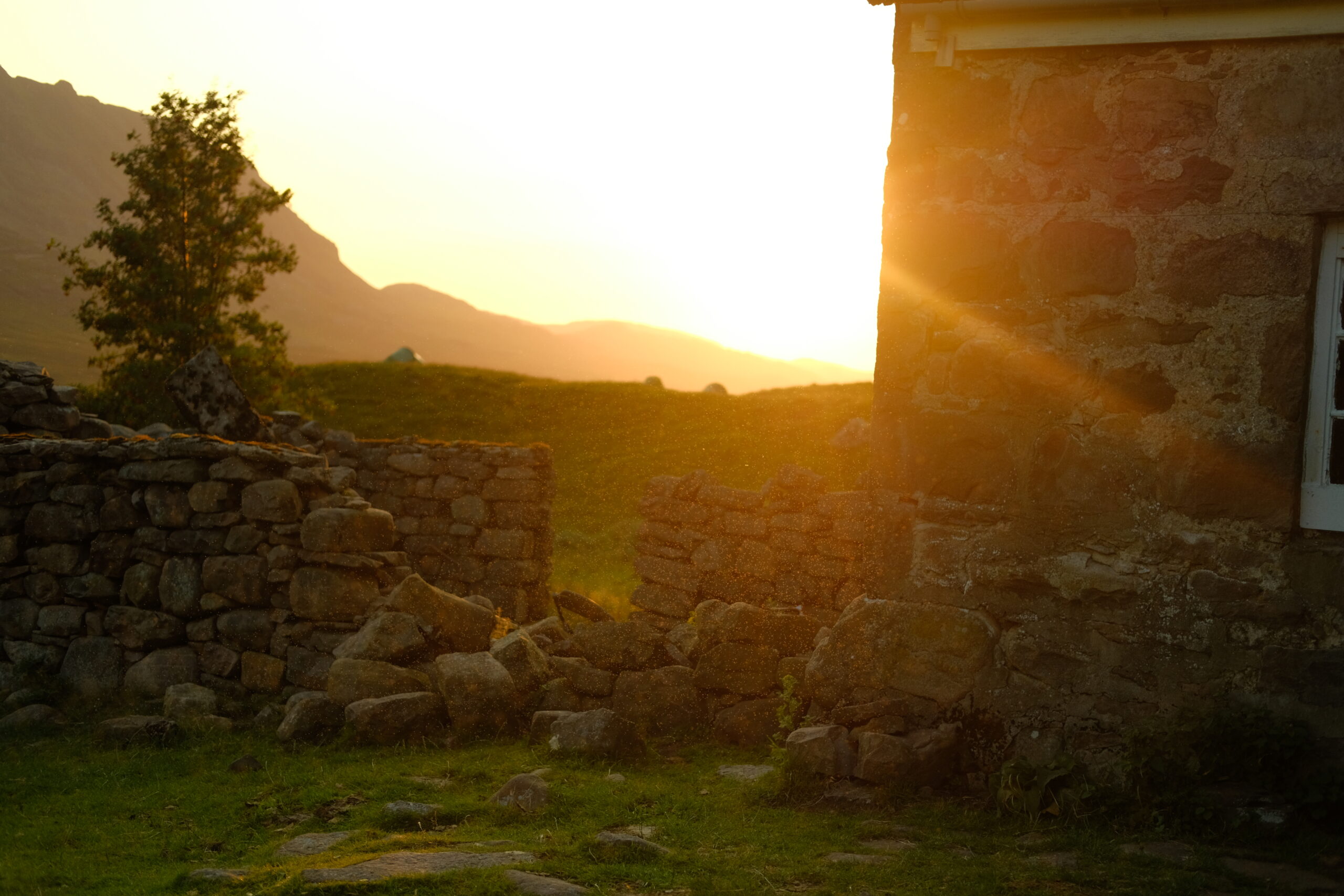
The Fisherfield ...?
In the end, there’s 6 people in the attic that night. Snoring, midges and heat drive me in and out of sleep, and at 6 AM I wake up knackered. We aim for an early start to increase our chance of success, and to be ahead of a potentially hot sun. Over my cup of morning tea, Bob, an Englishman whose birthday it is today and who completed his last mainland munros last night, and Núria, a Spanish mountaineer, give me conflicting advice about the best direction from which to approach the Fisherfield Six. The usual route is clockwise, but if we don't think we'll manage, we ought to go anti-clockwise, so that at the very least we get to see the stunning view from A’ Mhaighdean. Núria, however, argues that the views are better clockwise, and the steepest sections are best tackled uphill rather than downhill.
Ultimately, we decide to hike clockwise, and when we climb the first hill, the relentlessly steep corbett Beinn a’ Chlaidheimh (914 m), we understand what Núria meant: we’d have literally rolled down this slope. There’s no trail, on this hill it’s every man for himself; who can find the quickest way up the steep heather and overhanging rocks? The summit is covered in fog, but on the bealach to the first munro of the day, the sun breaks through. Sgùrr Ban’s cone is half green and half white, as if a giant has swept a brush over its flank.
On Beinn a’ Chlaidheimh we battle stiff shrubs, on Sgùrr Ban (989 m) it’s thousands of quartzite boulders, all the way to the summit. The hilltop itself is a wide plateau, that hides the spectacular surroundings from view.
By now we’ve hiked a good 6,5 hours, and my feet are sorer than ever. This has never been a problem before and I don’t know what caused it; did my heavy rucksack strain them yesterday, is it my worn-out boots, or just bad luck? Whatever it is, it makes the descents almost unbearable. Especially the one from Sgùrr Ban, where grit and loose rocks roll away under my feet. Joevie, in turn, struggles with her knees. This is why we almost welcome the zigzagging trail that climbs up (don’t ask me to pronounce this) Mullach Coire Mhic Fhearchair ’s slope at an seemingly impossible gradient. Ascending is exhausting but it shifts our weight. With 1019 m the munro is the highest hill of the day, but its climb turns out to be the most pleasant. Steep but short from the bealach, over firm sand with enough hand- and footholds.
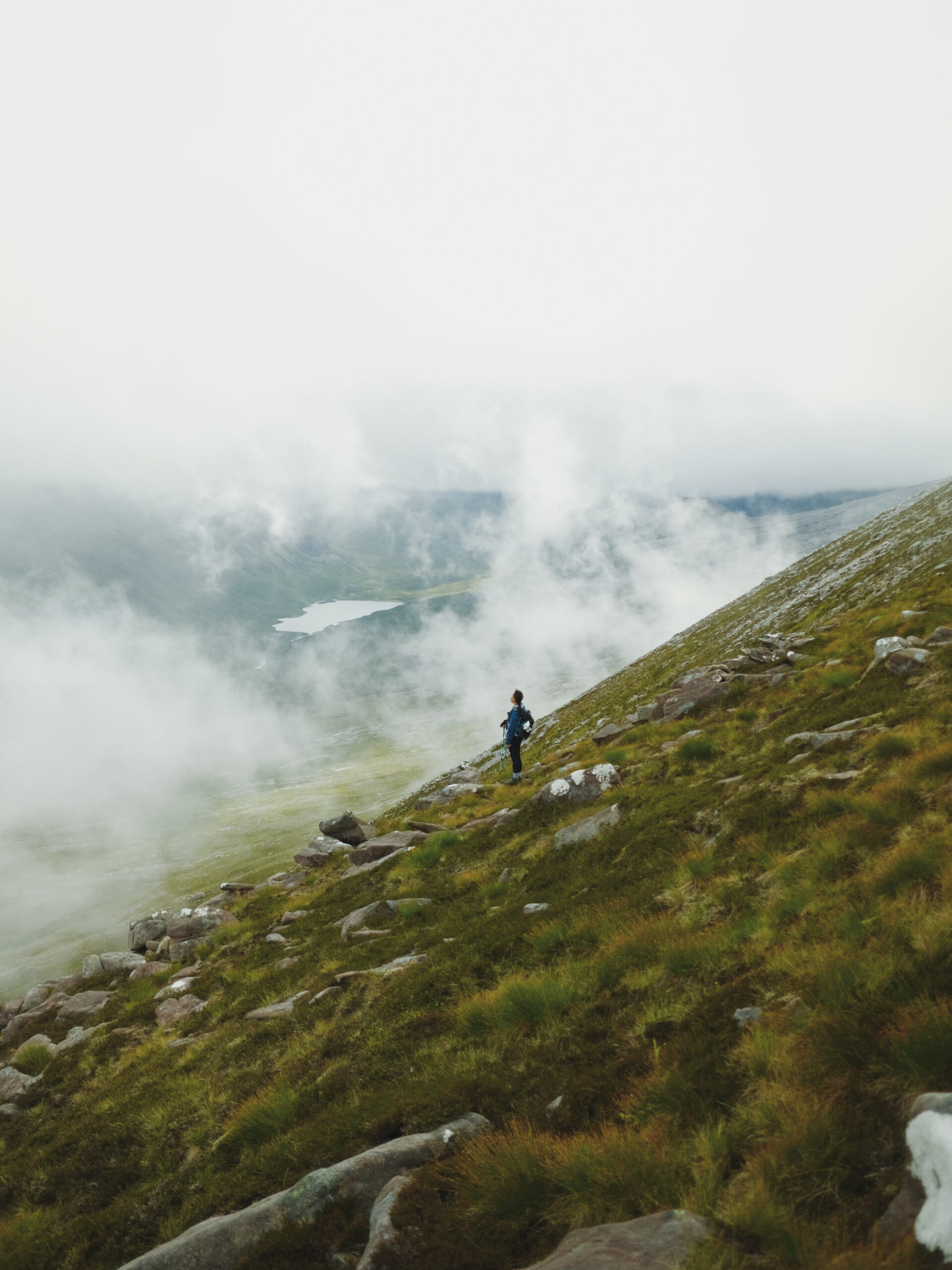
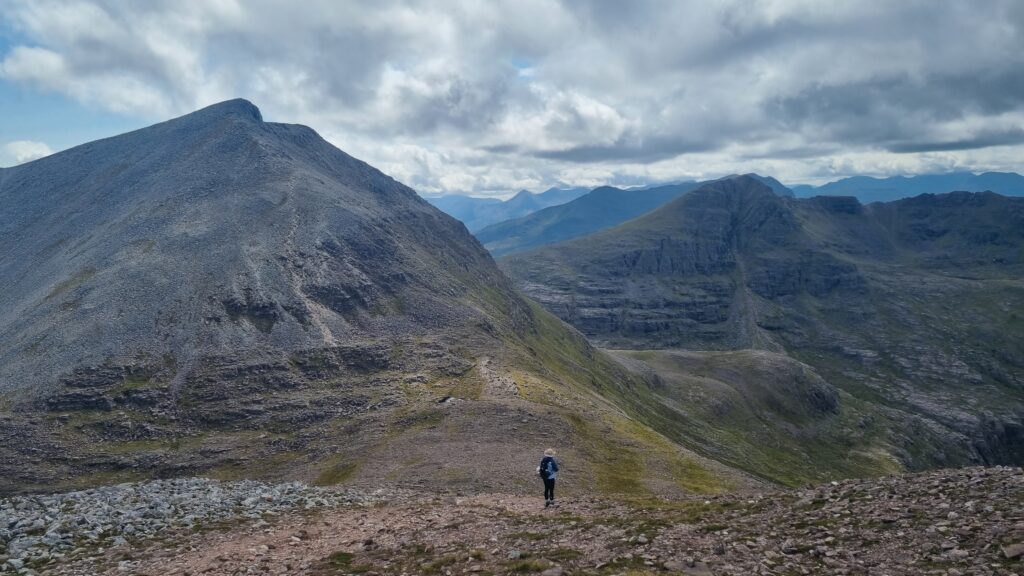
The apex then, and finally that panoramic view over the Fisherfields. Ragged hilltops on all sides, for miles and miles. On the ledge below us, the first hikers of the day are heading towards us. It’s a remarkable thing, to have vistas like this all to yourself in the middle of summer. Everyone who wanted to make use of the narrow window of good weather, seems to have done so yesterday, but today is an excellent day out on the hills as well, though fickler. The clouds provide shelter and the wind gusts are a welcome relief from the hot sun.
The hikers are a German couple who are walking the Fisherfield Six anti-clockwise and camped on Beinn Tarsuinn (937 m), the hill in front of us, last night. They fill us in on the pathless sections yet to come and the large bog field on the long saddle between Beinn Tarsuinn and A’ Mhaighdean (967 m).
We take stock. It’s 15:15; we have 13 km behind us, and 17 more to go according to my GPS. This morning we have lost a lot of time to the hellish climb of Beinn a’ Chlaidheimh, but in the last few hours we've made good progress despite our sore knees and feet.
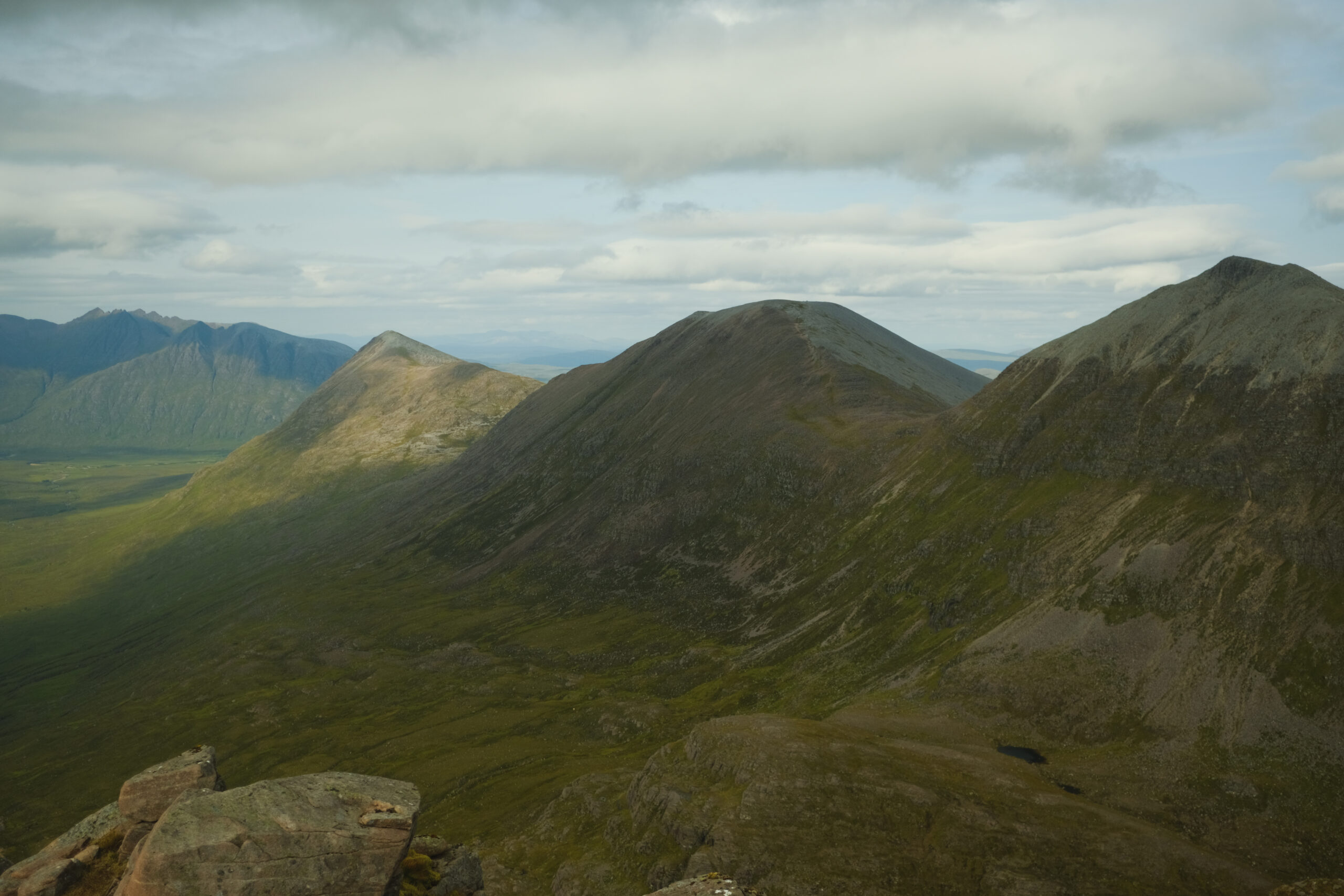
Ahead of us lies the slanting slope of Beinn Tarsuinn, a low bealach, then A’ Mhaighdean and Ruadh Stac Mor (919 m) across the glen, our two final ordeals, now still a far cry in the distance. Three hills ahead and three behind us, it’s a turning point – if we go on from here, we won’t go back. Then we’ll finish what we’ve started. It could prove quite a challenge to reach Ruadh Stac Mor before sunset. But we stand a chance, if we keep our momentum.
Every descent grows steeper, and every step heavier than the last. On these hills I’ve developed a hatred for loose rocks. The ascent to Beinn Tarsuinn is gentler, but feels hard on me; my body is starting to wear out.
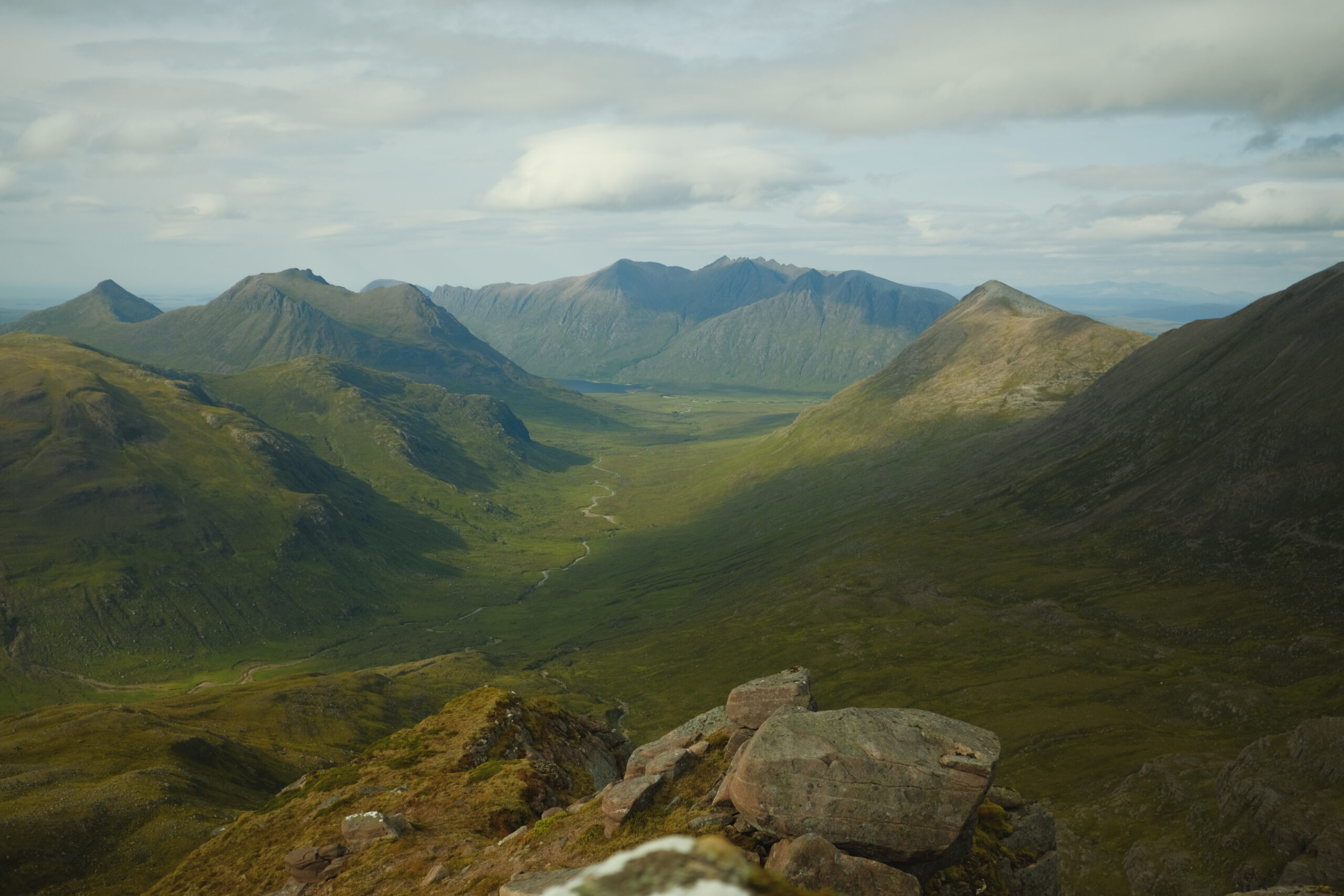
The summit of Beinn Tarsuinn is another superlative viewpoint. This time we look right into Gleann na Muice, the U-shaped valley that divides the Fisherfield Six. An Teallach is flaunting his beauty at its far end. We can look back on the three giant hills we’ve just climbed. What an enormous distance that we’ve covered. To our left, Beinn Tarsuinn becomes a narrow ridge and sloping plateau, that looks completely out of place in its surroundings. It’s as if a huge sword has sliced off the tip of its crest. Beyond the plateau the ridge narrows into a series of pinnacles, but to the left our path branches off and drops down the hillside – this descent even steeper and longer than the last, with more of those damned rolling stones. I cannot do it anymore, I accept my defeat, and slide down on my buttom – oh what a relief for my poor feet.
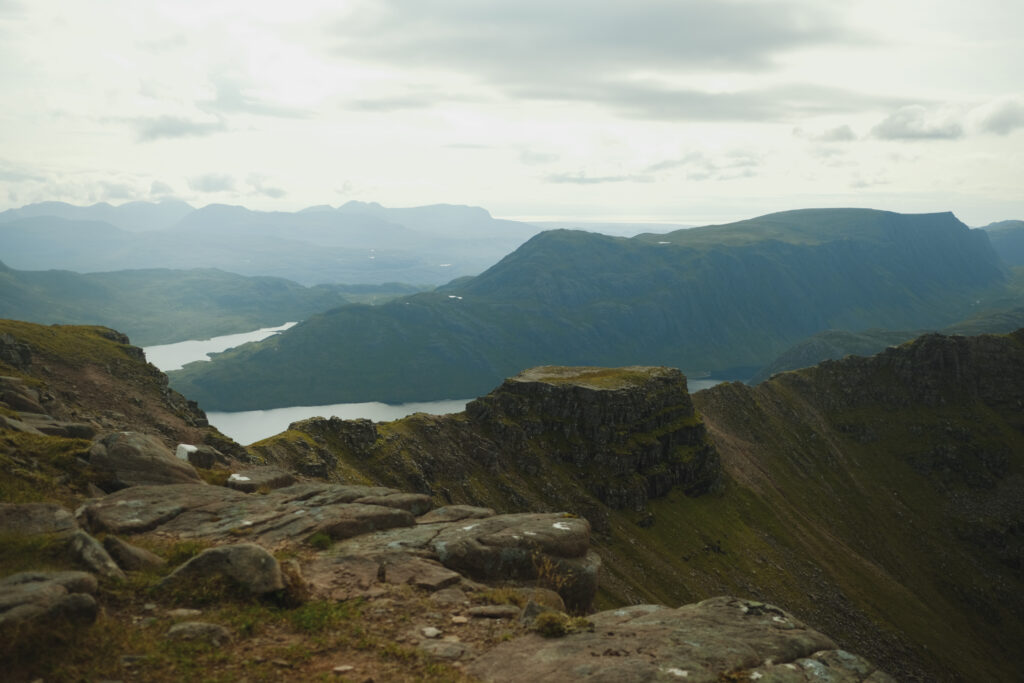
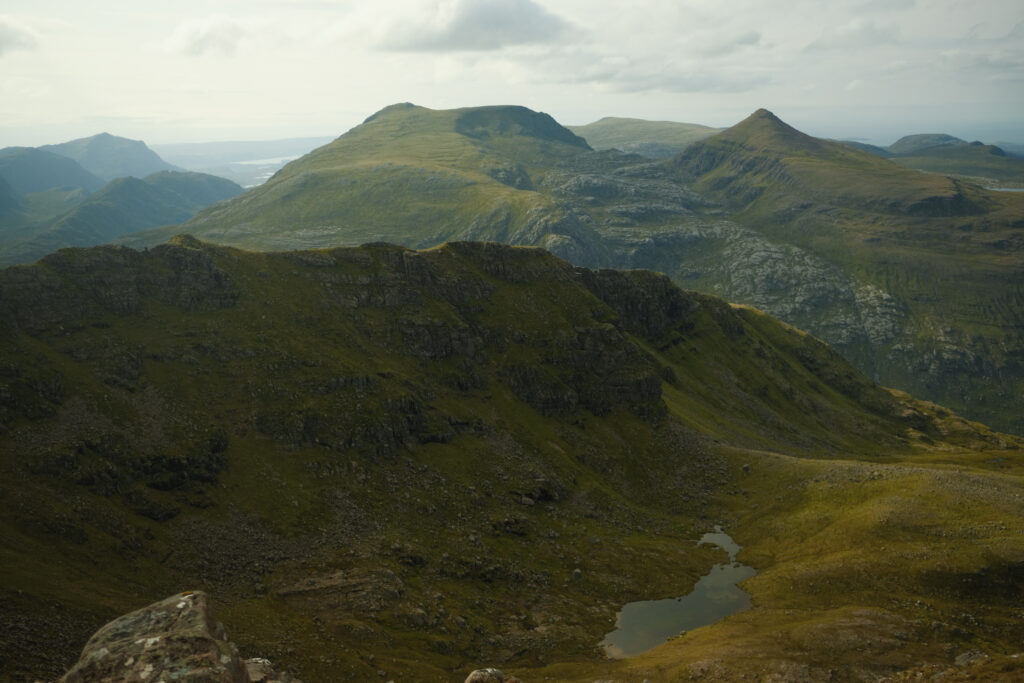
On the go we fuel ourselves with chocolate and nuts; nevertheless we need more and more breaks. The extensive bealach to A’ Mhaighdean is indeed extremely boggy, but nothing we aren’t used to in Scottish winters. We maneuver around it. Slowly, the penultimate munro comes within reach. The sun has vanished behind dark clouds, and a change can be felt in the air.
It’s a real strife getting up A’ Mhaighdean; 400 meters up a deceivingly long grassy slope. False summit after false summit, it’s seemingly endless, but that could also be our exhaustion. I force myself to keep going, cause the moment I stop, I’d give up immediately.
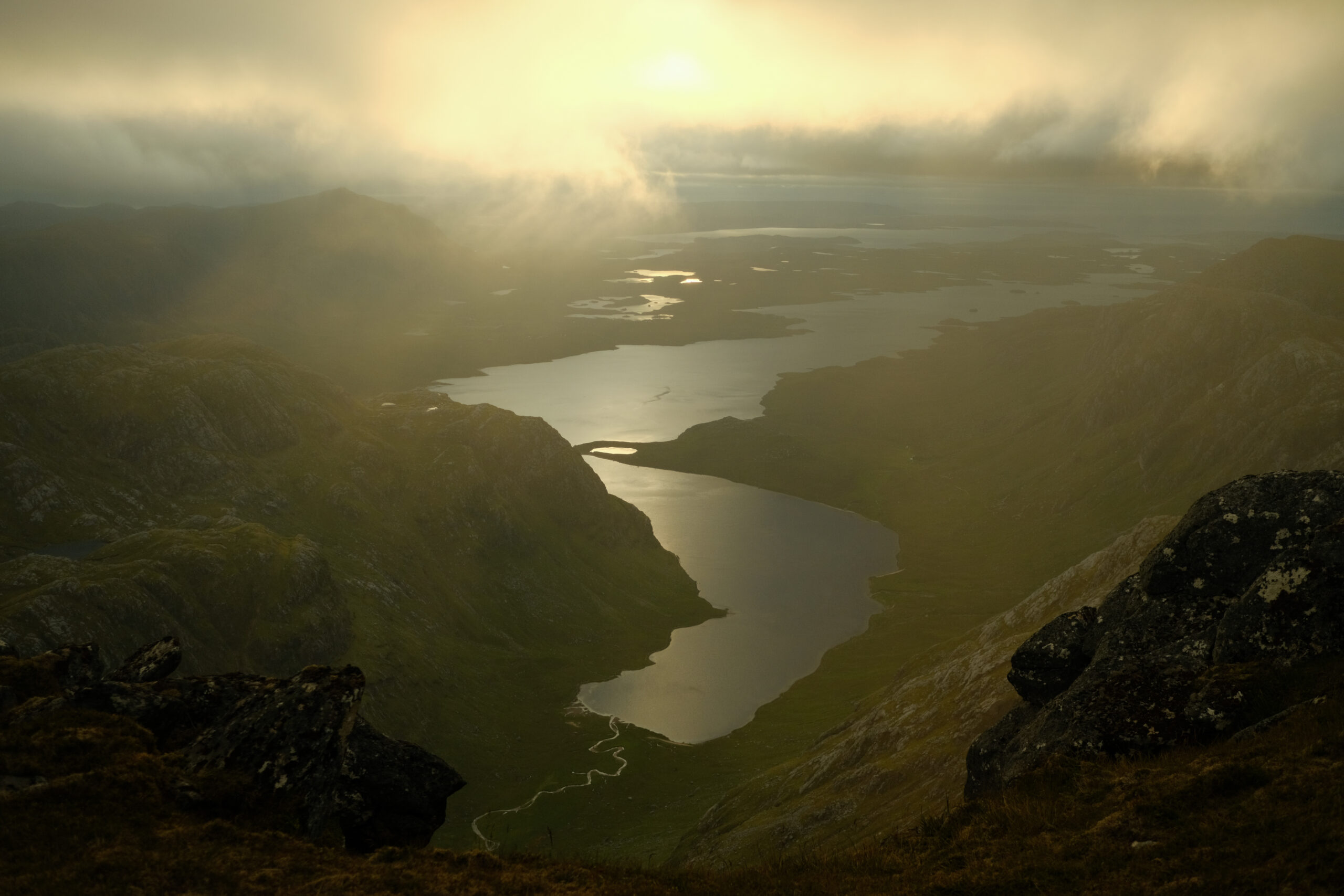
It’s half past eight when, at long last, we can peer over the edge of A’ Mhaighdean, ‘The Maiden’. The sun makes a brief appearance, and lights up twisting Dubh Loch and Fionn Loch all the way to the sea. It’s a magical moment, standing on one of the remotest peaks of Great Britain, but it’s hardly sinking in; I’m already preparing for what comes after this. I can just about distinguish the trail winding its way up the vertical cliff of Ruadh Stac Mor. The falling darkness and rising wind make it seem extra daunting.
Hastily, we descend to the bealach, our pains numbed by our nerves. We watch out for an escape route down into the glen, but all we find are cliffs. When we approach Ruadh Stac Mor, clouds have darkened the sky, and the trail to the top disappears in the shadows of the rocks.
To try and conquer her now would be an act of hubris; exposing our worn bodies to forces greater than us, just so we can say we stood on that sixth peak, whose views we won’t even be seeing. Would that make us any different from Icarus who flew too close to the sun?
No, I know the message the mountains are giving me, and I know my limits. So when we find a gully that seems to give way to the bottom of the glen, we take it. Ruadh Stac Mor, the Great Red Stack, remains unconquered.
The dark, magic night
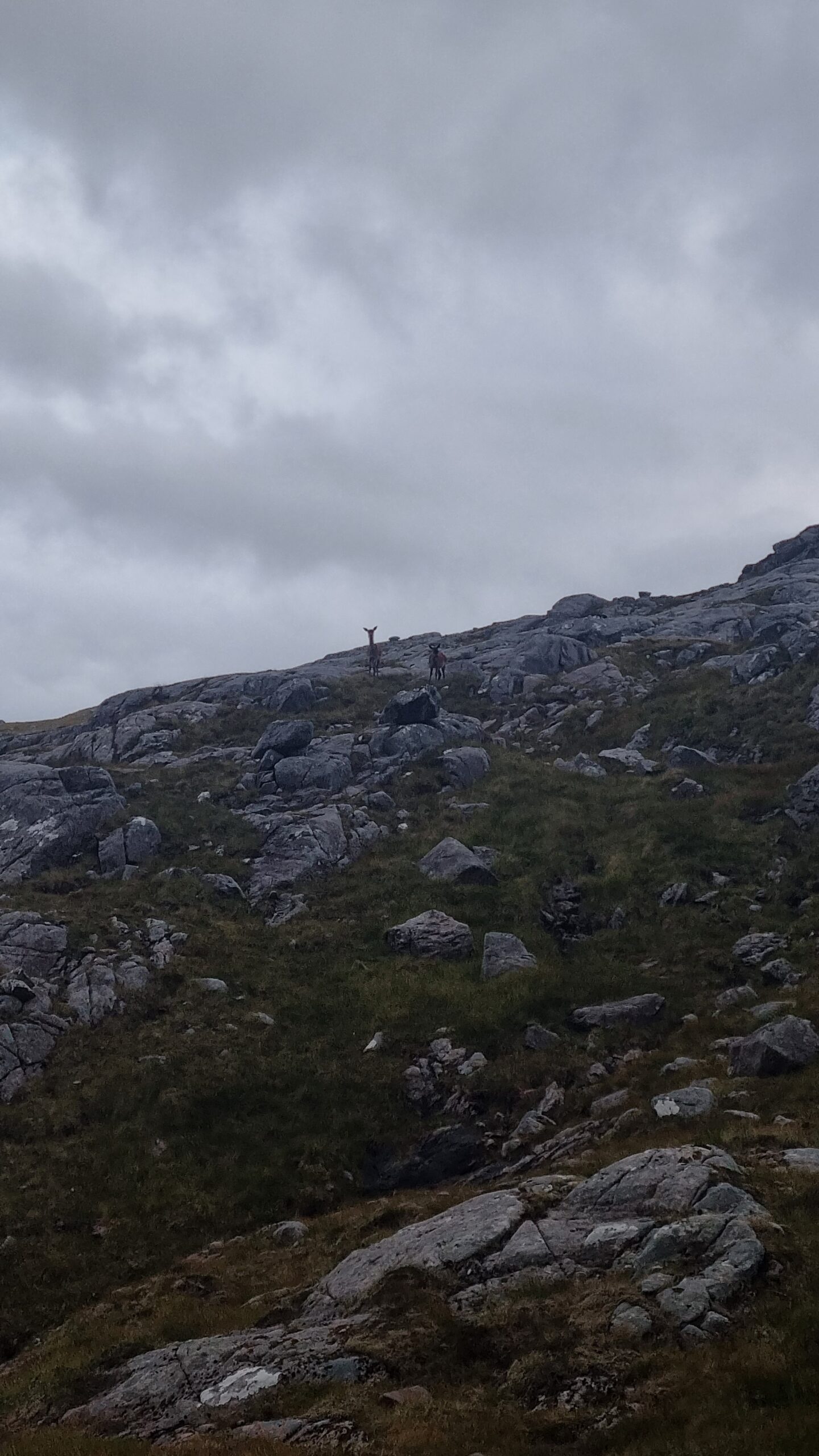
We leave the wuthering hill behind, and enter a lost kingdom. Where a herd of deer leads our way, then vanishes in the gloom. Where the river is our trail, until it ends in a fall. Two does keep an eye on us from the hilltop. Their watchful eyes are a silent comfort.
We descend from 750 to 250 meters and the hills become large shadows above us. We scramble down steep rocks and wild vegetation. Sometimes the precipice below us seems impassable. We slip, rip our clothes, but the gully is forgiving. Finally, the faint flickering river appears down in the valley. There’s only a grassy slope between us and the shore.
We feel great relief, but we are far from there. There’s 8 more kilometers to go through the glen, and those kilometers promise the be the most gruesome. Night has fallen, and we face her on an empty stomach.
It’s an epic again: finding our way back to the bothy, while our legs are falling out. Over clefts along the riverbank, over bumpy fields that torment my ankles. Sometimes we find a faint trail through the tall grass, a brief respite.
The night is turbulent. Now and then, stars make a fleeting appearance in the sky, before clouds waver over them. We can’t rest long, or we’ll cool down too much. At least the wind scares the midges away.
Eight kilometers is far, no matter how fast you walk. It’s even further when you already have 25 kms in your legs. I walk through those last hours in a semi-conscious state. My primal instincts take over from me. Behind me Joevie hums as if hypnotised, her last spark of fire.
The darkness bewilders me, every hill looks the same. But when the time comes to cross the river, I know the end is near. Recent draught has left the water level low, but I don’t have the patience to find a shallow place to cross. I barge through the water, not caring if I get wet.
The last mile is straight through a horrible swamp. It swallows me up to my knees. I don’t care about that either. Just give me a roof above my head.
One last river crossing and we’re there. From our shore we cannot tell that the place where we cross leads to a dense forest of gorse, impossible to cross. I follow the river upstream, my clothes soaking, seeking a gap, but there is none. Back to the shore then, and further up we try, once again.
We are desperate to find the bothy. A roof! Joevie shouts, but it's merely a tree. Then there's the reflection of windows and what were miles, has shrunk to meters. White eyes light up in our headlamp; tents on the grass field, but a few are moving. The deer welcome us home.
I worry that we took it a step too far today, that the arduous journey back overshadows our big accomplishment. From the moment we went off-trail, my only priority was getting Joevie and me back safely to the bothy. Because of this I paid little attention to the beauty around me.
But when we crawl into our sleeping bags at 2 am, 18 hours after we set off, Joevie is gloating. Finding our way down the gully, deer looming over us, was her favourite moment of the day.
I admire Joevie for her unfeigned wonder. Even the toughest ordeals will bring a smile to her face.
To me, a dark glen is familiar territory – last November I walked half of the West Highland Way in darkness. Sometimes I forget the sensations of the night, the magic and the thrill, the rocking trees and black hills. But now I think back of the awe I felt on my first night hike through the Southern Uplands, the awe that Joevie must have felt tonight. I’m grateful she reminds me of it.
That night my feet are throbbing with pain, but my heart throbs louder, for the love the mountains give me. One day I shall return and conquer Ruadh Stac Mor. But for now it’s our Fisherfield Five, that is etched in my heart.
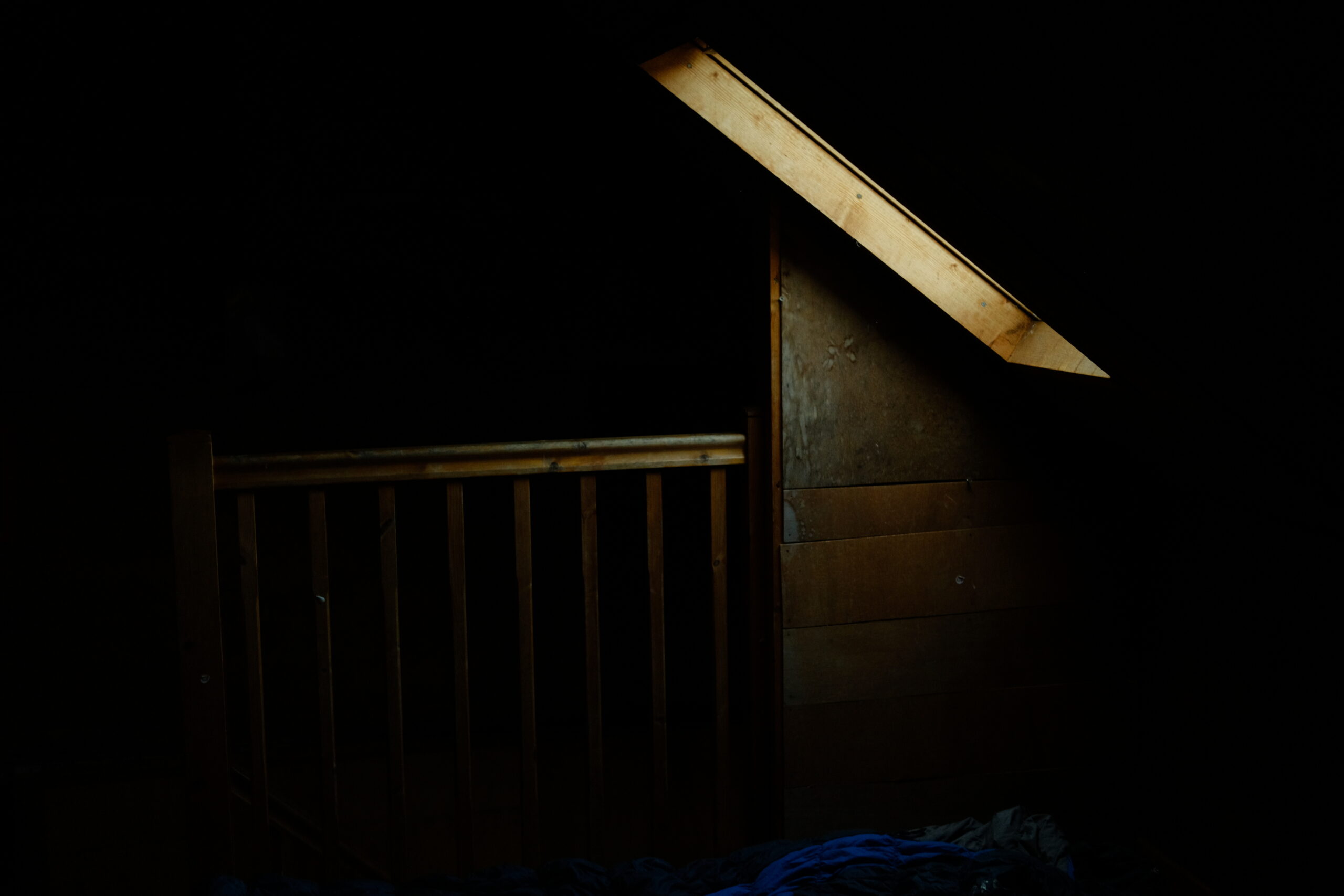
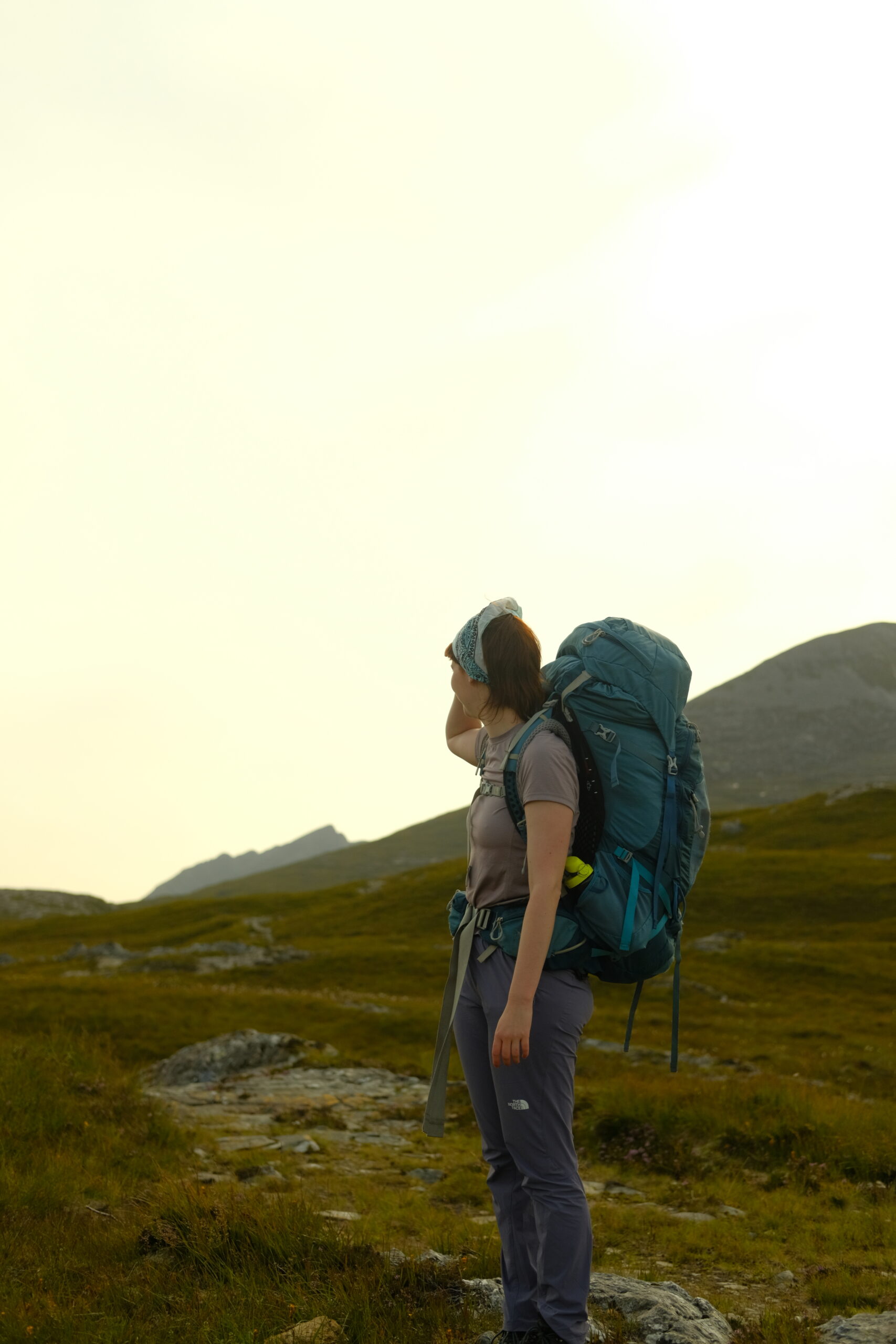
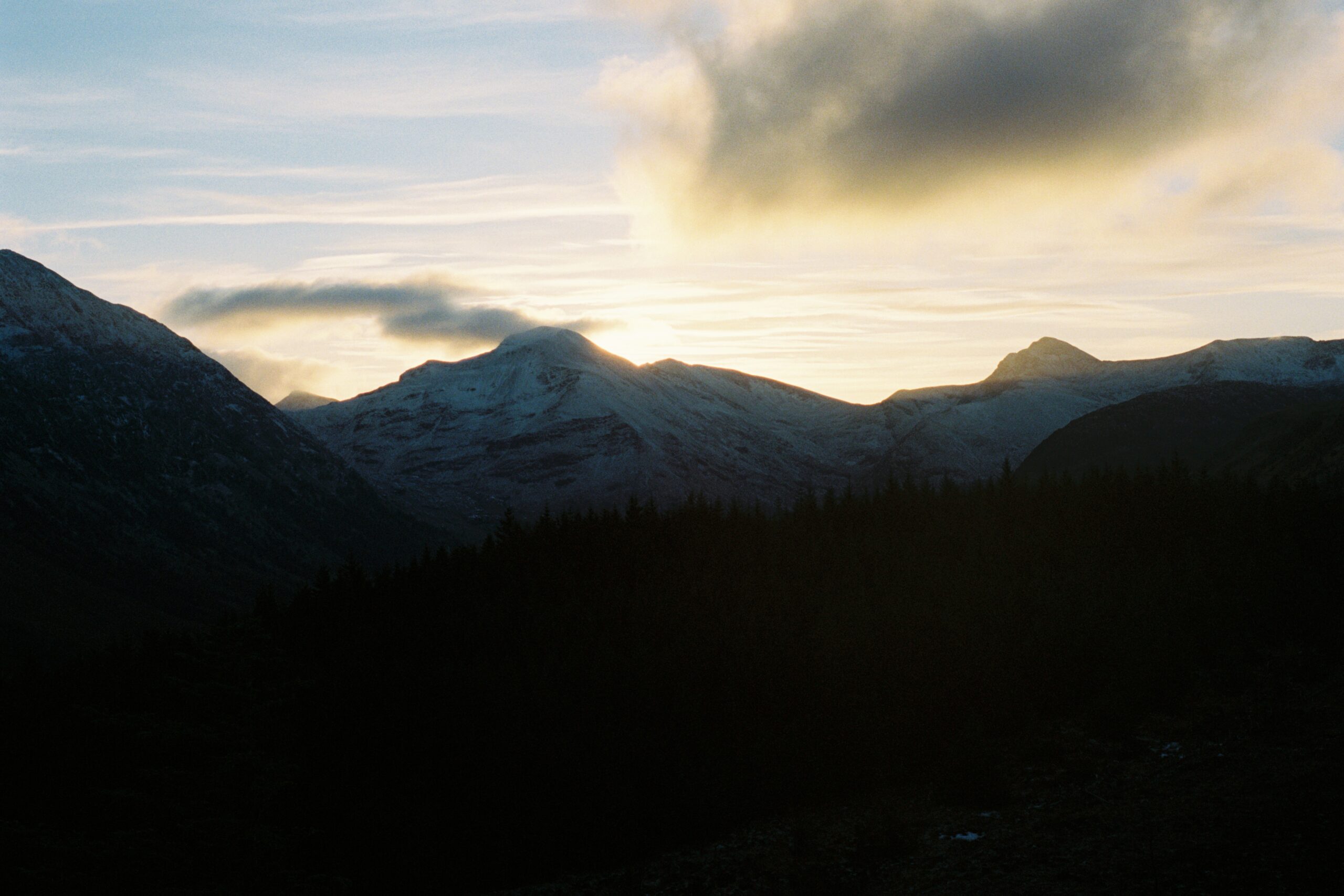

Leave a Reply